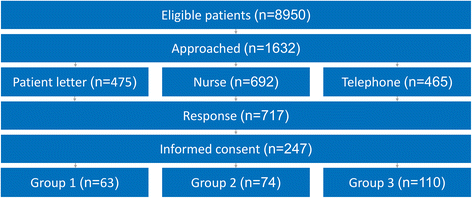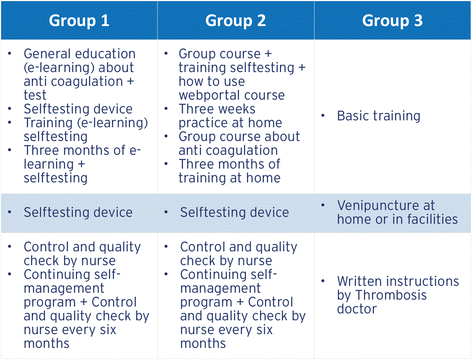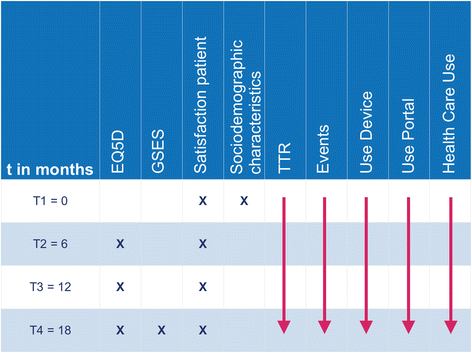PORTALS: design of an innovative approach to anticoagulation management through eHealth
- PMID: 28302116
- PMCID: PMC5356357
- DOI: 10.1186/s12913-017-2142-2
PORTALS: design of an innovative approach to anticoagulation management through eHealth
Abstract
Background: For the monitoring of International Normalized Ratio (INR) values, venous thromboembolism (VTE) and atrial fibrillation (AF) patients can visit anticoagulation clinics, laboratories, or physicians for venous puncture. Point-of-care testing (POCT) made it possible for patients to monitor INR themselves (self-monitoring) and even self-adjust their medication dosage (self-dosage). Both skills are accepted as forms of self-management. eHealth applications can improve this self-management, resulting in better clinical outcomes.
Methods: Our study, called PORTALS, aims at identifying the optimal implementation strategy of training to improve self-management and explore factors that enhance good self-management skills. In addition, the relationship between the implementation strategy of training, clinical outcomes, and individual characteristics will be investigated. Of the 247 recruited participants, 110 chose to continue with regular care. 137 patients have been randomly divided in subgroups and compared using a parallel cohort design: one group will be trained and educated by e-learning, and the other group will receive face-to-face group training.
Discussion: More insight in factors that enhance good self-management will help to improve clinical outcomes and patient satisfaction on anticoagulation therapy. Our study will provide practical insights and knowledge of eHealth in daily practice and of the importance of education on the adoption of self-management. We expect the self-management program including training to help patients to better manage their own INR values and medication use, thereby increasing health status and diminishing thromboembolic events and hospitalisation.
Trial registration: The Netherlands National Trial Register, number NTR3947 .
Keywords: Anticoagulant therapy; Atrial fibrillation; Self-management; Self-monitoring; Venous thromboembolism; e-learning; eHealth.
Figures





Similar articles
-
Effect of a combined education and eHealth programme on the control of oral anticoagulation patients (PORTALS study): a parallel cohort design in Dutch primary care.BMJ Open. 2017 Sep 27;7(9):e017909. doi: 10.1136/bmjopen-2017-017909. BMJ Open. 2017. PMID: 28963313 Free PMC article. Clinical Trial.
-
Patient self-management of warfarin therapy: pragmatic feasibility study in Canadian primary care.Can Fam Physician. 2011 Aug;57(8):e292-8. Can Fam Physician. 2011. PMID: 21841092 Free PMC article. Clinical Trial.
-
Accuracy of point of care coagulometers compared to reference laboratory measurements in patients on oral anticoagulation therapy.Thromb Res. 2016 Apr;140:66-72. doi: 10.1016/j.thromres.2016.02.006. Epub 2016 Feb 20. Thromb Res. 2016. PMID: 26901852
-
Patient self-monitoring of oral anticoagulant therapy: potential benefits and implications for clinical practice.Am J Cardiovasc Drugs. 2001;1(4):245-51. doi: 10.2165/00129784-200101040-00003. Am J Cardiovasc Drugs. 2001. PMID: 14728024 Review.
-
International normalized ratio self-testing and self-management: improving patient outcomes.Vasc Health Risk Manag. 2016 Oct 12;12:387-392. doi: 10.2147/VHRM.S85031. eCollection 2016. Vasc Health Risk Manag. 2016. PMID: 27785043 Free PMC article. Review.
Cited by
-
Effect of a combined education and eHealth programme on the control of oral anticoagulation patients (PORTALS study): a parallel cohort design in Dutch primary care.BMJ Open. 2017 Sep 27;7(9):e017909. doi: 10.1136/bmjopen-2017-017909. BMJ Open. 2017. PMID: 28963313 Free PMC article. Clinical Trial.
-
Clinical service organisation for adults with atrial fibrillation.Cochrane Database Syst Rev. 2024 Jul 29;7(7):CD013408. doi: 10.1002/14651858.CD013408.pub2. Cochrane Database Syst Rev. 2024. PMID: 39072702 Free PMC article.
References
-
- CBO Richtlijn Diagnostiek, preventie en behandeling van Veneuze trombo-embolie en Secundaire Preventie Arteriele trombose 2009 [CBO Diagnostics Guidelines, prevention and treatment of venous thromboembolism and secondary prevention of arterial thrombosis 2009].
-
- Meer van der FJM. Zelfmanagement van antistollingsbehandeling- consequenties voor de toekomst? [Self-management in anticoagulation treatment - consequences for the future?] NtvG 2011; 155: A3691. - PubMed
-
- NHG-Standaard Atriumfibrilleren [NHG Guideline Atrial Fibrillation]. Huisarts Wet 2013;56(8):392–401
-
- Bouillon K, Bertrand M, Maura G, Blotière PO, Ricordeau P, Zureik M. Risk of bleeding and arterial thromboembolism in patients with non-valvular atrial fibrillation either maintained on a vitamin K antagonist or switched to a non-vitamin K-antagonist oral anticoagulant: a retrospective, matched-cohort study. Lancet Haematol. 2015;2(4):e150–9. doi: 10.1016/S2352-3026(15)00027-7. - DOI - PubMed
Publication types
MeSH terms
Substances
Associated data
LinkOut - more resources
Full Text Sources
Other Literature Sources
Medical

